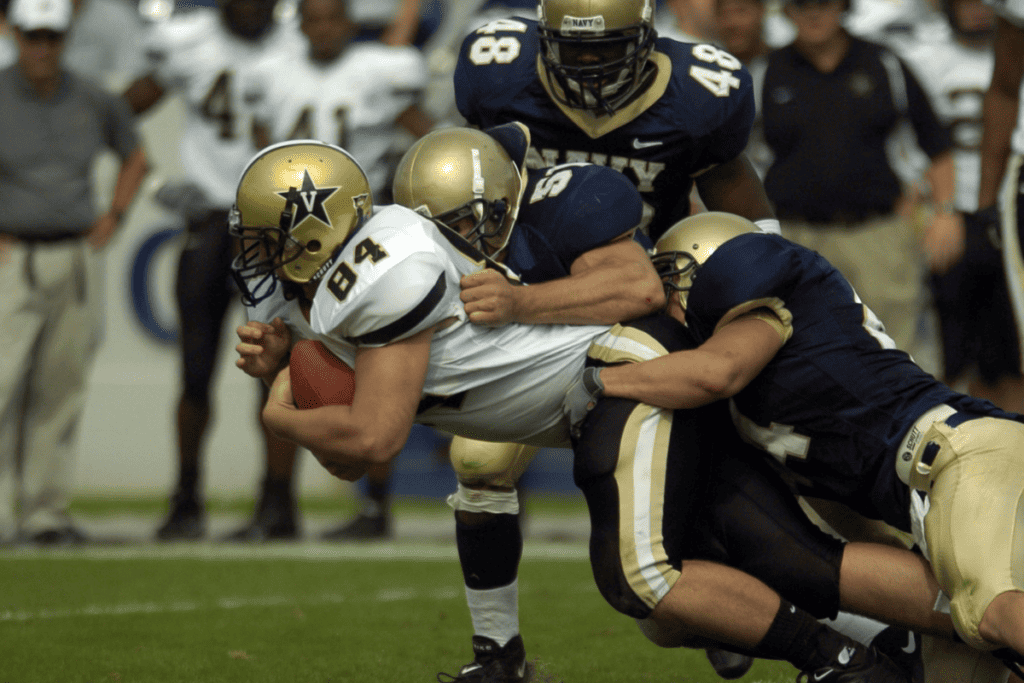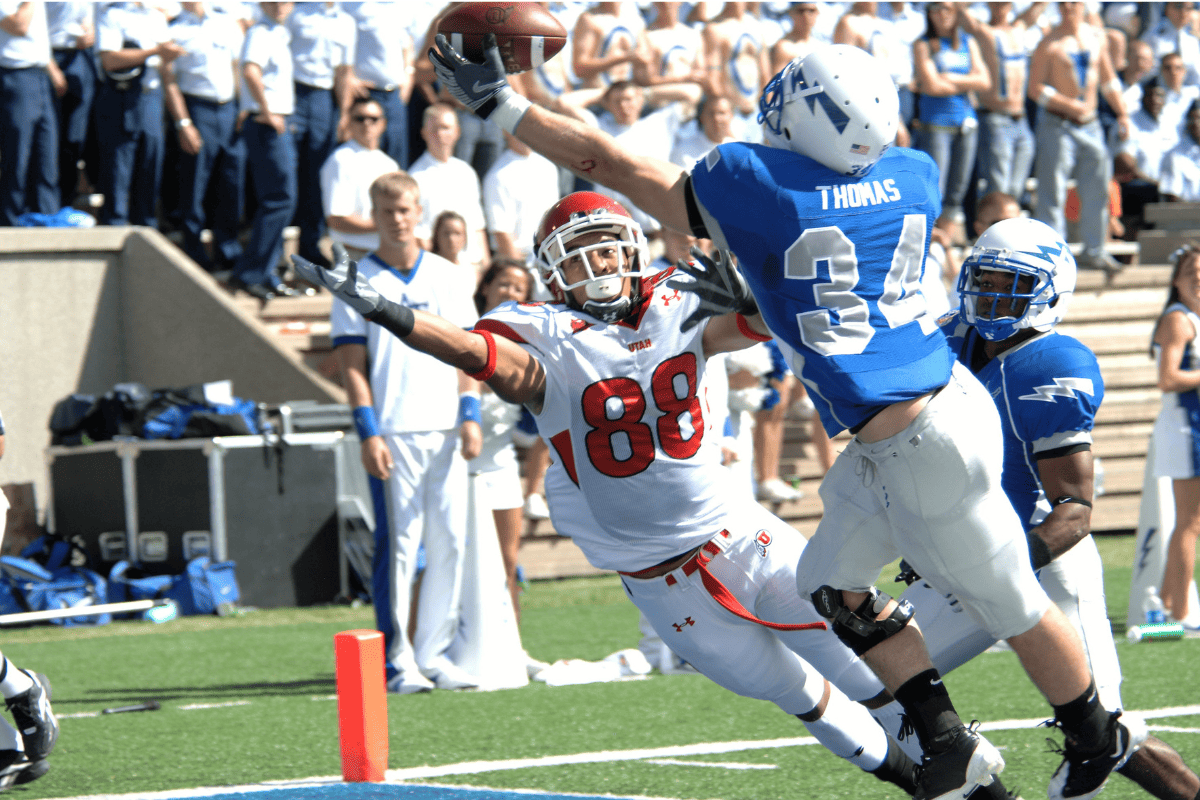Wide Receiver vs Tight End (Similarities & Differences)
For those new to American football, understanding the various positions and their roles on the field is key to appreciating the game’s strategic depth. Among the offensive positions, wide receivers and tight ends stand out for their critical roles in the passing game, yet they serve distinct purposes with different skill sets and responsibilities.
While they both catch passes, the way they operate and contribute to the offense varies significantly. This article aims to demystify these positions for newcomers, highlighting the differences and similarities between wide receivers and tight ends, and illustrating how they uniquely impact the game.
Wide Receiver: Speed and Agility on the Sidelines

The wide receiver is a pivotal player in any football team’s offensive strategy, primarily known for their role in the passing game. Lining up near the sidelines, wide receivers are tasked with running precise routes to get open for passes from the quarterback.
Their primary objective is to catch the ball and gain as much yardage as possible, often leading to spectacular touchdowns. Wide receivers need to possess a blend of speed and agility, which allows them to create separation from defenders and make quick adjustments to catch the ball. The ability to run a variety of routes effectively and a deep understanding of defensive coverages are also crucial.
Wide receivers play a significant role in stretching the defense, creating space on the field, and providing key options in the aerial attack. Their explosive plays and ability to turn a short pass into a long gain make them essential to any dynamic offense.
Key Skills for an Effective Wide Receiver
To excel as a wide receiver, certain core skills are indispensable. Speed is perhaps the most critical attribute, enabling them to outrun defenders and get open for passes. Agility and quickness are essential for executing sharp, precise route-running, allowing receivers to create space and make themselves available for passes.
Good hand-eye coordination and exceptional catching ability are paramount, as wide receivers often receive high-speed passes and must catch the ball in challenging situations, including tightly contested coverage. Route-running expertise, which includes understanding various route patterns and the ability to adjust routes based on defensive schemes, is crucial.
Additionally, wide receivers must possess an awareness of the field, enabling them to make split-second decisions, such as when to cut a route short or find open space in the defense.
Tight End: Versatility at the Line of Scrimmage

The tight end is a unique position in football, combining the responsibilities of a receiver and a blocker. Positioned on the line of scrimmage next to the offensive linemen, tight ends play a dual role in both the passing and running games.
As receivers, they are eligible to catch passes, often serving as reliable targets for short to intermediate throws, particularly in red-zone situations. Tight ends are typically larger and stronger than wide receivers, making them effective blockers for running plays and providing crucial protection for the quarterback during passing plays.
This versatility makes the tight end an invaluable component of the offense, capable of contributing in various capacities depending on the play call and game situation.
Read More:
Essential Abilities for a Successful Tight End
The skill set required for a successful tight end is a blend of physicality and agility. Strength and blocking ability are essential, as tight ends frequently engage with defensive linemen and linebackers to create running lanes or protect the quarterback.
Good hands and receiving skills are also crucial, as tight ends need to be able to catch passes, often in traffic or tight coverage. Route-running ability, while different in style from that of a wide receiver, is important for tight ends to get open for receptions.
Additionally, tight ends must have a comprehensive knowledge of both the passing and running games, as their role can shift from one play to the next. Football intelligence and versatility are therefore key attributes for players in this position.
Contrasting Roles: Wide Receiver vs Tight End
While both wide receivers and tight ends are integral to a team’s passing game, their roles and the way they contribute to the offense are markedly different.
Wide receivers are primarily pass-catching specialists, known for their speed and ability to make plays in open space. They are usually smaller and faster than tight ends and operate primarily on the outskirts of the formation.
Tight ends, on the other hand, are more versatile players who balance their responsibilities between catching passes and blocking. They are typically larger and stronger, capable of engaging physically with defenders, and often line up closer to the center of the formation.
Common Ground
Despite their differences, wide receivers and tight ends share several key aspects in a football offense. Both are essential components of the passing game, providing quarterbacks with various target options.
They must possess a comprehensive understanding of the team’s offensive playbook and be adept at reading defenses to adjust their routes or blocking schemes accordingly. Good hands and catching ability are crucial for both positions, as securing the ball is their primary way of contributing to the offense.
Additionally, both wide receivers and tight ends require teamwork skills, as they often work in tandem with other receivers and blockers to execute plays effectively. Their roles may differ, but their shared goal is to advance the ball and create scoring opportunities.
How Wide Receivers and Tight Ends Complement Each Other
The strategic interplay between wide receivers and tight ends is vital for a successful offense. Wide receivers, with their speed and route-running abilities, stretch the defense horizontally and vertically, creating space in the secondary.
Tight ends, with their size and versatility, can exploit mismatches against smaller defensive backs or slower linebackers. In passing situations, tight ends can provide reliable short-to-medium range options for the quarterback, while wide receivers target deeper routes.
In running plays, tight ends’ blocking abilities are crucial in creating effective running lanes. This complementary relationship between the two positions challenges defenses and adds depth to the team’s offensive strategy.
Iconic WRs and TEs in Football History
Football history is rich with legendary players who have excelled as wide receivers and tight ends, leaving lasting impacts on the game. Iconic wide receivers like Jerry Rice, Randy Moss, and Calvin Johnson have set high standards with their exceptional receiving skills, speed, and ability to make big plays.
Similarly, renowned tight ends such as Tony Gonzalez, Rob Gronkowski, and Shannon Sharpe have redefined the position with their combination of receiving prowess and blocking skills. These players have not only showcased the importance and impact of their respective positions but also inspired future generations of athletes in the sport.
Conclusion
Knowing the roles of wide receivers and tight ends is crucial for anyone looking to deepen their appreciation of football. While wide receivers are celebrated for their speed and playmaking abilities on the outskirts of the formation, tight ends bring a unique combination of physicality and versatility at the line of scrimmage.
Both positions, with their distinct yet complementary roles, contribute significantly to the complexity and excitement of the game. Appreciating the nuances of these roles enriches the experience of watching football, revealing the strategic depth that defines the sport.

